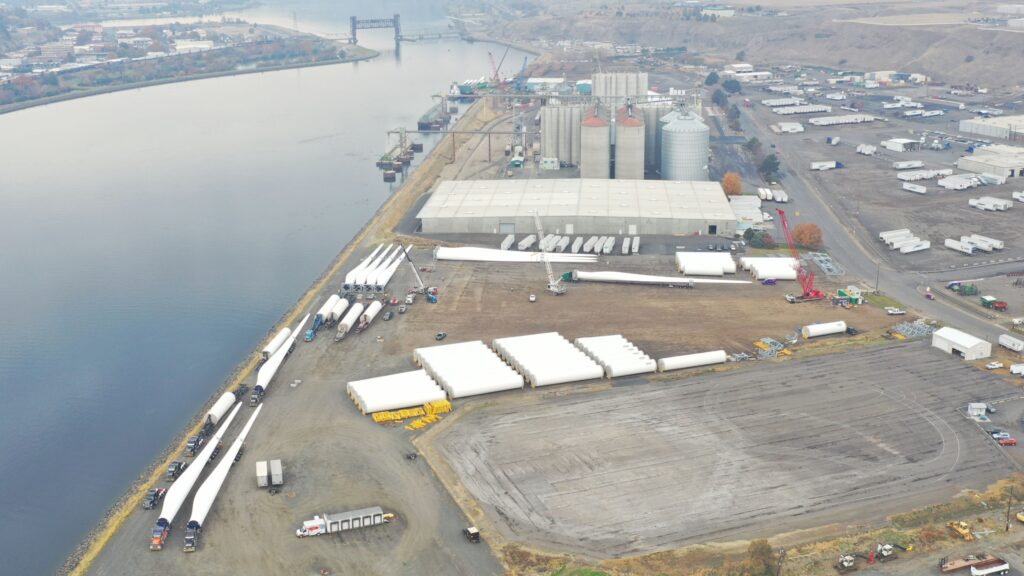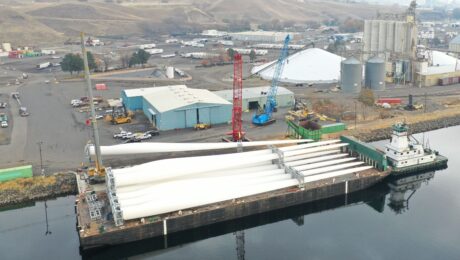New residents are just one factor in rise in Spokane home values
This article first appeared in the Journal of Business on January 14, 2021. By Patrick Jones, executive director of the Institute for Public Policy & Economic Analysis at Eastern Washington University.
Supply side said to have greater effect as listings fall short of local demand
Ever thought it’s those out-of-towners who have driven up housing prices here recently? You probably aren’t alone.
After all, the median house price for resale has climbed from approximately $284,000 to $330,000 over the past four quarters.
That $46,000 represents a 16% bump, a steep one for buyers. Spokane’s median price, while still considerably lower than the state value, cruised upward at a slightly higher pace than Washington’s median, which rose 14% over the past 12 months. (Supporting data is available on Eastern Washington University’s Spokane Trends website.)
Prices reflect many forces, both demand and supply. The key drivers of housing demand are income, financing, and population. Incomes here have moved upward in the past few years, but at a rate not too far from historical rates. For sure, mortgage rates have plummeted, leading some homeowners to consider trading up and some renters to consider buying.
Population growth, too, has surged over the past four years, relative to the past two decades. And like most western U.S. cities, Spokane’s population has expanded largely due to migration.
Local families continue to keep OB-GYNs busy, but in the larger scheme of things, it is migration that moves the population needle. For example, from April 1, 2019, to April 1, 2020, the number of heads in Spokane County rose by 7,350. Of those, 85% can be attributable to net migration.
Net migration accounts for the difference between those who move in and those who move out. Over the past five years, the number of county residents here due to net migration has been slightly more than 25,000. That’s a large jump from the prior five years.
Has it been just me who has seen more out-of-state license plates on Division Street or Interstate 90 since the pandemic struck? Observations from behind the wheel are not optimal research techniques. Thankfully, we can look at a public data series: driver’s license surrenders tracked by the Washington state Department of Licensing.
The surprise result for the first 11 months of the year: out-of-state license surrenders have dropped. From January through November the Department of Licensing reports about 7,700 new residents from outside of our state exchanging driver’s licenses. That total is down from 9,160 and 10,830 for the first eleven months of 2019 and 2018, respectively. So much for casual empiricism.
In retrospect, that shouldn’t be too surprising. The early months of the pandemic’s outbreak put a hard stop to mobility in this country.
A comparison of license surrenders in the second quarter of this year with the second quarter of 2019 is startling: 104 this year versus 2,360 last year.
Undoubtedly, the low numbers from this year are due to the closure of state offices for a good part of the quarter. Yet the third quarter, when obstacles to reregistering ostensibly were removed, didn’t compensate for the prior quarter. Licensing data show a gain of little more than 200.
In sum, the continued discovery by those from out-of-state, so strong in the recent years, shifted gears in 2020.
Yet, inflows might still be strong from movers within the state. The U.S. Census tracks annual flows from county to county in the U.S, compiled over five-year intervals. The most recent period is 2014-2018. It clearly shows the flow of Washingtonians to our county to be considerable.
Over that interval, the ratio of new residents to Spokane from Washingtonians to those outside of the state was just slightly below even. That is, a few more new residents have recently come from outside the state than from the other 38 counties in Washington.
It might be the case that the pandemic has changed that relationship, making it relatively easier for residents of Evergreen State counties to move here than those from hundreds of miles away.
In fact, among the top 10 U.S. counties contributing to in-migration here over the 2014-2018, period, seven were in Washington. Ranked by size of their flows, these were: Snohomish, King, Benton, Grant, Pierce, Stevens, and Lincoln counties.
Of the two out-of-state counties, one, not surprisingly, is neighboring Kootenai County, and the other, perhaps surprisingly, is Maricopa, Arizona. Though not a county, Asia as a whole rounded out the top 10.
Most of us have heard anecdotes about neighbors or friends of friends who have moved here from the central Puget Sound area. Many of the accounts describe the new residents as remote workers. That arrangement may well be part of the new normal for our economy and in particular for tech workers.
If so, these new neighbors symbolize a hope held by many in the economic development community: Someday Spokane will benefit from an arbitrage of labor from high-cost to lower-cost urban centers.
It is this observer’s hunch that current movement from other Washington counties has mirrored the decline of out-of-state new residents in 2020.
As a consequence, fingers can’t be pointed at Seattleites for the dramatic run-up in housing costs. Until we have data for 2020, we simply won’t know.
Attempts to explain housing prices solely to increased demand, however, miss half of the equation, perhaps the greater half. The supply side must be considered. Here, as has been widely noted, the offering of Spokane homes has been lowest on recent record.
The Washington State Real Estate Research Center, source for some of the housing data on Spokane Trends, tracks the number of listings by quarter in the county. For Q3 2020, the most recent quarter for which data are available, the count stood at 558. Compare that with 1,158 listings in Q3 2019, or 2,562 listings in Q3 2015.
Population has grown, incomes have grown, financing has gotten much more favorable, yet supply has diminished. Clearly this is a textbook case for rising prices.
The supply of homes (listings) rests on two sources: the number of local households selling their homes and the number of new homes coming onto the market. Spokane Trends doesn’t track the latter, but does follow residential building permits, typically viewed as a leading indicator. (See indicator 2.3.3.) The graph clearly shows a peak in 2016, followed by a decline of 500 permits into 2019.
The reasons behind the decline are numerous.
They include: difficulty in securing land, the cost of developing lots, a tight labor pool in the building trades, and the rising costs of construction, especially lumber. Some of these forces might see some relief relatively soon, but others will take longer to resolve.
That is, unless hundreds of current Spokanites decided to sell and move to a different place. That doesn’t seem to be in the offing now. The pandemic has kept local residents place-bound, too. Once our community reaches a safe threshold of vaccinations, I don’t expect a big outflow. Continued low supply, growing popularity from outside the region, continued low financing costs, and no significant rise in departures imply rising home prices for the foreseeable future.
- Published in News + Updates
Port of Lewiston Wind Turbine Shipping Project
For the last few months, the Port of Lewiston has become an important transportation center for wind turbine components being barged up the Columbia and Snake rivers. After being barged from Port of Longview, in Washington, to the Port of Lewiston, the components will be trucked to Alberta, Canada.
Because the Port of Lewiston is at the end of the navigable Columbia Snake River System, it serves as a transportation corridor for commodities exported from Idaho or cargo imported to the interior of the U.S. and Canada.
The wind turbines are shipped in pieces to the Port’s dock, which was expanded as part of a 2013 capital investment project made possible by federal and state grants, and then trucked north using U.S. Highway 95 to the Canadian border. The wind turbine components will be assembled to make 42 new wind turbines.
The Port of Lewiston is an advocate for renewable energy sources such as hydroelectric power as well as wind power. Wind turbines work to harness the power of the wind and turn it into energy. When the wind blows, the turbine’s blades spin clockwise, capturing energy. This triggers the main shaft of the wind turbine, connected to a gearbox to spin. The gearbox sends that wind energy to a generator, converting it to electricity. Wind power generation helps to create a clean, renewable way to power our world.

Both blades and tower components have been barged and stored on Port property before being trucked to Canada.

126 turbine blades and 168 tower components have been shipped on 21 barges of this project.
This project is important to so many, especially during this COVID-19 time. The crew that is shipping these turbine components was mobilized to our area and is helping to fuel the local economy. The Port of Lewiston is a public organization serving the citizens of Nez Perce County as an economic development district, intermodal transportation center and facilitator of international trade.
“The success of this inland shipping route will foster future opportunities for the Port of Lewiston and the Valley as a whole,” General Manager, David Doeringsfeld, commented.
- Published in News + Updates
URM grocery purchases old Northwest Bedding facilities on West Plains, adds clients on coast
This article first appeared in the Journal of Business on October 22nd, 2020. . Written by Natasha Nellis
Spokane-based wholesale cooperative URM Stores Inc. has purchased the former Northwest Bedding complex on the West Plains to accommodate ongoing growth, as the organization expands west of the Cascade Mountains.
Located at 6102 S. Hayford Road, just west of the Amazon Fulfillment Center and north of West Plains Building Supply, the newly acquired property includes two warehouses with nearly 140,000 square feet of floor space—one with 117,900 square feet of space and the other with 16,000 square feet.
The structures will be used as additional staging and storage space, says Mike Winger, vice president of store development.
“It gives us some flexibility to better utilize the main URM facility,” he says.
A commercial change-of-use application on file with Spokane County shows tenant improvements in both structures are valued at about $12.4 million. URM purchased the 13.8-acre property for $3.7 million in September, according to Spokane County Assessor’s Office records.
The recently acquired Hayford Road structures previously operated as a boat manufacturer, Sun Runner, from 1977 to 1991 before transitioning into a Northwest Bedding manufacturing facility, says James Black III, Realtor with NAI Black who handled the transaction. The property has been vacant for roughly two years.
The expansion comes on the heels of a double-digit growth in revenues during the most recent fiscal year.
In its 2020 fiscal year ended July 31, the company experienced double-digit sales growth and closed out the year at a consolidated annual revenue of $1.3 billion, up 13% compared with 2019 revenue, Winger says.
Much of that growth is attributable to the COVID-19 pandemic, as more people cook at home and drive up sales at grocery stores, which in turn drives up sales at the wholesale cooperative, he says.
“The way the virus has impacted the restaurant trade has really changed people’s eating habits, and a lot of our retailers have experienced significant sales growth because people are now going to the grocery store and buying a lot of that center-store grocery product,” he contends.
Winger says it’s likely the new facilities will operate with a limited staff, as the facility is intended to be used as a temporary dry food storage facility. However, he adds, the significant growth and demand the company has seen this year has led to over 80 new hires at the URM headquarters, and the company is looking to add 30 to 35 additional employees before year’s end.
URM currently has over 670 employees.
In addition to eliminating periodic expenses related to off-site storage during the holiday seasons, the new facilities give URM expanded storage capabilities that Winger says will allow the company to better serve its growing client base in the large Pacific Northwest metropolitan areas.
“With the growth of our company, we’ve been pushing our trade area farther west,” says Winger. “Now, we service grocers over in the Seattle and Portland area.”
He adds that as more retailers are added to the company’s roster, the demand for specialty products could increase. The new facility will help to accommodate those products that the company headquarters, at 7511 N. Freya, currently doesn’t now.
Further, he says the grocery industry is continuously evolving, with new products being added every day, organic products growing in popularity and diversity, and ethnic foods growing in demand.
The new space will give the company the flexibility to accommodate those needs in the future as the company’s retailer base diversifies, he contends.
During the holiday season, the distributor often rents additional space to store the candy and other holiday treats the member companies only stock seasonally, Winger explains, so having the additional space will cut that expense.
The West Plains facilities currently are undergoing tenant improvements to ensure that the buildings are up to date with code requirements, he says. The buildings also aren’t connected to city water or sewer systems, and instead operate on a private well, so the company is inspecting them to ensure the life safety systems are operational, he adds.
Winger says improvements are slated to be completed by spring 2021.
“We have, for some time, been looking to see how we could expand our existing warehouse facility. We’re somewhat limited because we have the railroad property to the west of us and we have streets on either side,” he says of the company’s headquarters on Freya Avenue.
Much of the planned work is cosmetic, adds Winger. Additionally, the structure’s roof will be replaced, portions of the steel panel wall will be repaired, and the loading docks will need to be repaired or replaced to be properly sized for the company’s trucks, he says.
URM’s flagship distribution center on Freya Street is 680,000 square feet. According to the company’s website, its distribution center receives over 400 inbound truckloads weekly and ships over 450 outbound truckloads a week.
Its headquarters were established in Spokane in 1926. Since, the company has steadily expanded its space, with its last addition occurring in 2014 when the company added 77,000 square feet to its perishable groceries space.
URM services members in Washington, Idaho, Montana, and Oregon. Its offerings include dry groceries, frozen food, ice cream, deli foods, dairy products, fresh meat, general merchandise, and health and beauty aids.
The 99-year-old cooperative is a member-owned food distributor to grocers that include Center Place Market, Family Foods, Harvest Foods, Huckleberry’s Natural Market, Rosauers Supermarkets, Super 1 Foods, The Markets LLC, Town & Country Markets Inc., Yoke’s Fresh Market, and Northwest Grocers.
The company also provides supplies to two URM Cash & Carry stores.
Next year URM Stores will celebrate its 100th year, says Winger.
- Published in News + Updates
Some regional retail setting holiday sales records in 2020
this article first appeared November 5 in the Spokane Journal of Business. Written by Kevin Blocker.
Extended holiday shopping season benefits some here
Despite the fact thousands of retail storefronts across the U.S. have struggled or gone away in recent years, some Spokane-based retailers say they could be on the verge of all-time holiday sales records in 2020.
As the pandemic’s surge continues to strengthen heading into late fall, so too does consumer demand for some products as the holidays near.
At the General Store, general manager Mark McKee says he’s fully prepared for both store locations to set holiday records this season. The General Store, located at 2424 N. Division, and The General Store Outpost, at 1330 N. Argonne in Spokane Valley, last year partnered with ACE Hardware to carry its brand of tools and hardware.
The day after the region’s Oct. 23 snowstorm, the Division store set a single-day sales record, McKee says. Though he declines to disclose an actual dollar amount, he says Oct. 24’s single-store revenues were 150% above the same date in 2019.
“This year, both stores are up 45% year to date,” says McKee.
Online sales in 2020 have driven a substantial part of growth at both locations. Meanwhile, the North Division flagship store has gotten a steady facelift throughout the year.
“We’ve made the store more shoppable,” McKee says. “And something new here for us is that we’re launching a toy department on Nov. 14.”
As for in-store shopping, McKee says checkout stands will be reconfigured in an effort to create an even more socially distanced experience.
The store recently began offering curbside delivery, and for those customers with medical mask exemptions, The General Store offers full face shields for customers to use, he says.
“We want to be able to maintain full safety for customers and employees,” he says.
Chris White, the store manager at Wheel Sport cycle shop at 9501 N. Newport Highway, in North Spokane, says the company’s four stores have seen a 35.7% increase in revenue this year over 2019.

Chris White, store manager at Wheel Sports’ North Side shop, says sales are up a whopping 340% this year, and some products are difficult to get in stock.
And despite the fact this time of the year is considered off-season for riding bicycles, White says bikes have been a strong holiday gift traditionally.
Wheel Sport operates four stores across the region, and all share each other’s inventory. When asked if he was concerned about the company’s ability to fulfill holiday orders, White says, “Unfortunately, yes. Very few people anticipated this.”
He advises people to shop early for Christmas gifts; the store only recently received a pair of bikes he had ordered in April.
“If you’re going to wait to start shopping after Thanksgiving, then it’s going to be too late,” he asserts.
Mark Schneider, who owns and operates Rambleraven Gear Trader, an outdoor gear and clothing store at 3220 N. Division, says he’s feeling optimistic about a strong consumer holiday shopping season.
Schneider says Rambleraven is currently “fully stocked” with outdoor gear.
Schneider says Rambleraven has picked off traffic from the closing of Mountain Gear, which occurred at the beginning of the year.
“It’s hard to predict tomorrow, but one of the shining stars through the pandemic is the outdoor economic sector,” Schneider says. “There’s been a year-long, pent-up need for people to maintain their sanity.”
The Washington, D.C.-based National Retail Federation launched its nationwide consumer education campaign encouraging people to shop earlier and safer due to the pandemic.
“We know this has been a year unlike any other,” NRF President and CEO Matthew McShay told the Associated Press in a late October interview. “And we ought to expect that the holiday season will be just as different from normal holiday seasons as the rest of this year has been from normal years.”
Despite the pandemic, the federation projects consumer spending on gifts will be on par with 2019, decreasing by only about $9 per person, while spending on other holiday items, such as decorations, will be up slightly.
“Expected spending remains significantly higher than the five-year average for both those categories. The holiday season is top of mind, with 42% of people saying they plan to start their holiday shopping by the end of October and another 41% in November,” the retail federation says.
NRF estimates the average adult consumer will spend $650 on gifts this year, up from the four-year annual average of $624 from 2016 to 2019. Consumers are expected to spend $230 on nongift holiday items, such as decorations, compared with the $217 annual average from 2016 to 2019.
The only category the retail federation anticipates seeing a decrease in consumer spending is on “other nongift purchases,” down to $117 per consumer compared with the 2016 to 2019 average of $145.
“One in five holiday shoppers say that they typically travel for the holidays but will stay home instead this year,” according to the retail federation. “Over half of those who changed their holiday travel plans said they are likely to spend more on holiday items this year, specifically because they will not be traveling.”
The retail federation says online sales have skyrocketed in 2020, and 60% of its survey respondents say they plan to purchase holiday items online.
Other top holiday shopping destinations for consumers include department stores, mentioned by 45% of respondent, discount stores (43%), and grocery stores or supermarkets (42%), NRF says.
The survey was conducted Oct. 1-Oct. 9 and sampled 7,660 total consumers, according to the retail federation.
Consumer zest for spending is still strong even though as of mid-August, a Business Insider report said retailers were expected to close more than 7,500 stores in 2020 following a record-high closing of more than 9,300 store closings in 2019.
- Published in News + Updates
Tamarack Aerospace expands Sandpoint facility
This article first appeared on October 8, 2020 in the Journal of Business. Written by Natasha Nellis.
Company to boost sales, engineering jobs this year
Tamarack Aerospace Group Inc. is continuing its rapid expansion, having nearly tripled its space at its Sandpoint headquarters.
The company has added 3,500 square feet of office space and an additional hangar to its 14,000 square feet of space at 2021 Industrial Drive, near the southern edge of the Sandpoint Airport. The addition of a third hangar, which company President Jacob Klinginsmith estimates is about 5,600 square feet, brings the company’s total hangar space to roughly 23,000 square feet.
“The big-picture objective with the expansion is making room for R&D,” he says. “As a technology company our intent and plan is to take our game changing technology and do it on other platforms.”
The company manufactures and installs active winglets, which are designed to be attached to wingtips to boost fuel efficiency by increasing lift and reducing drag.
Currently, the winglets are designed to be installed on Cessna CitationJets, but Klinginsmith says Tamarack is exploring expanding the product to fit other types of aircraft, from the CitationJets up to Boeing airplanes.
With the addition of more research and development space, the company also plans to hire five sales and engineering employees, with the expectation of hiring an additional five engineers by year-end, according to a company press release.
Tamarack has 27 employees.
Klinginsmith declines to disclose sales figures, but says he expects this year’s sales will be up compared with last year.
“The economy has really increased the demand for charter flights,” he says. “People are looking for less contact with others, so our charter customer base is growing. People are looking at adding winglets to get more out of their aircraft.”
He adds that the increasing popularity of charter flights has bolstered the company’s sales.
Earlier this year, the company also established its first international outpost at the London-Oxford Airport. Tamarack partnered with Jet Maintenance International, an airline-based asset management company based in Alexandria, Virginia, to lease an 18,000-square-foot hangar on the airport property.
- Published in News + Updates




